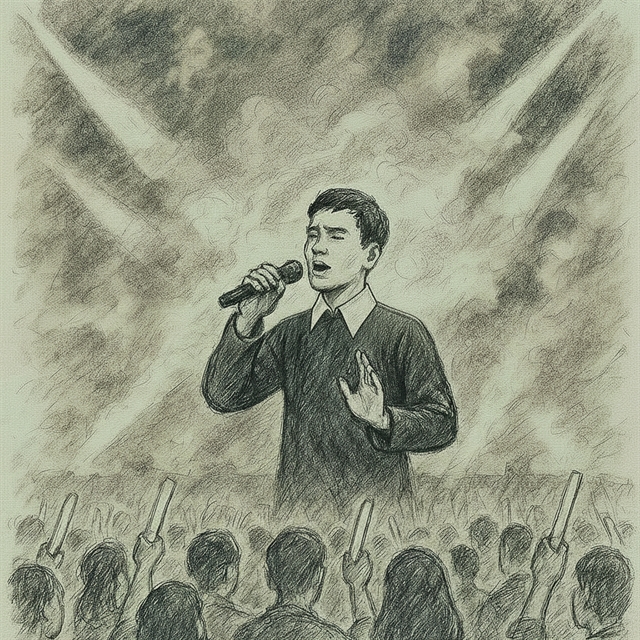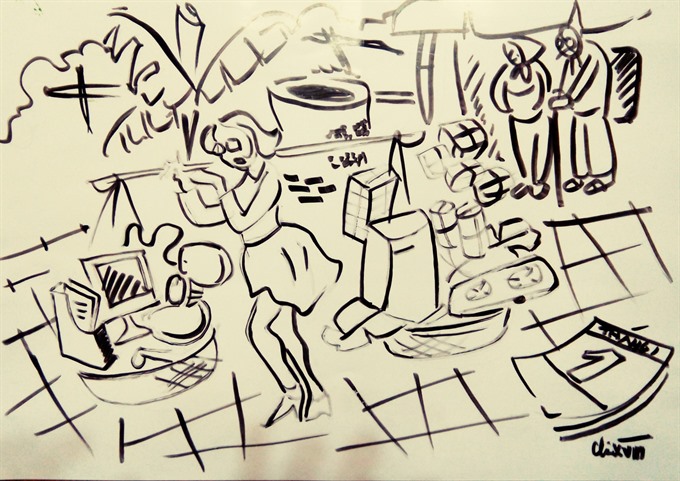 Talk Around Town
Talk Around Town

For most Vietnamese people, the Tết (Lunar New Year) Festival symbolises the beginning of a new year and the accompanying hopes for a happy life.
 |
| Illustrated by Minh Chí |
By Mai Hiên
For most Vietnamese people, the Tết (Lunar New Year) Festival symbolises the beginning of a new year and the accompanying hopes for a happy life.
No matter the family’s circumstances, people always prepare traditional dishes for ancestor worship with the hope that the ancestors will bless their descendants with good health, luck and prosperity in the Lunar New Year.
Traditional dishes like bánh chưng (square sticky rice cake), giò lụa (lean pork paste), thịt đông (frozen meat stew), canh măng (bamboo sprout soup) and nem (spring roll) are popular dishes around Tết.
The burden for preparing all of this falls to women. And the incomplete progress towards gender equality means that they must balance this task with many other responsibilities, such as career and childcare. As such, many specialities are more available for purchase and an increasing number of women, still expected by their families to serve the traditional meals, are selecting ready-to-eat food service to help them save time and effort.
Nguyễn Thu Huyền, from Hà Nội’s Thanh Xuân district, is among them.
As a chief accountant for a private company, she had to work until the last day before Tết.
Over the past two years, Huyền has usually hired people to prepare food and all that she has to do is display them on the family altar.
"With this service, I have more time to rest, play and take care of my children. I think this is a very convenient service, helping to share some of the burdens of women," she said.
Trần Thúy Hà, from Hai Bà Trưng District, has another story to share.
Living with her husband’s family after marriage, Hà had no chance to celebrate Tết the way she wanted for the past seven years.
She had to clean and decorate the house as well as rush to the supermarket to buy many things for the festival.
Now thinking that it is time to relax after a year of hard work, Hà has decided to order meals for this Tết.
She boasted she spent only fifteen minutes preparing food for the first three days of the Lunar New Year.
“The cost of the party with nine dishes for six people was reasonable, at about VNĐ1.5 million (US$66),” she said.
“With this kind of food, anyone without cooking skills can prepare parties for families and friends with less time,” Hà said.
In the previous Tết, she spent most of her time preparing traditional dishes for ancestor worship and cooking food for their family’s guests, which made her so exhausted she couldn’t enjoy the holiday.
However, purchasing ready-to-eat food is not something everyone favours, especially old people.
62-year-old Lê Thị Năm, from
In the past, people used to look forward to Tết to enjoy delicious foods. But now that the country is richer, many formerly special foods are available every day. What makes Tết food special is that it is prepared by families to eat together.
Vietnamese has its saying “uống nước nhớ nguồn” which roughly translates as “when drinking water, you should think of the source.”
Thus, she said, people should prepare delicious specialties by themselves on this occasion to show respect for ancestors and grandparents.
The food will be offered to the ancestors first, then served to the family during Têt, she explained.
Tết is the time that women are busy preparing dishes to worship the Kitchen Gods and ancestors, but also for all family members to get together and share the work, Năm said, adding that preparing traditional dishes for ancestor worship together helped tighten the relationship between family members because some of them haven’t met each other for a long time.
Historian Lê Văn Lan agreed.
“Whenever we asked an older person about his wish on the New Year, they would remember the warmth of family reunions. They could be the days that Kitchen Gods return to the Heaven, the gathering of family members around square sticky rice pot or the assignment of wrapping nem (spring rolls) on the eve of the Lunar New Year,” he told a local media.
During Tết, people visit one another, entertain with food and drinks, and greet each other with wishes for luck and happiness. This cultural custom reflects the Vietnamese people’s longstanding, durable relationship not only inside their families, but also in their native places.
In my opinion, though Tết is the time for togetherness and cohesiveness, most Vietnamese women are the most miserable as they bear the burden of preparing for the occasion. Why don’t we change to make Tết happier for them and they will have more time to relax?
I still remember when I was a small child, my mother was always busy preparing traditional foods like bánh chưng, dưa hành (pickled onion) or bamboo sprout soup as these foods take much time. For example, bamboo sprout should be soaked in water about half a month before Tết and the water needs to be changed every day.
As a result of exhaustion from Tết preparations, it was easy for my mother to get angry with us whenever we did things that she did not expect. At that time, we hoped that my mother could make a simple Tết for our family.
I think we have many ways to celebrate the New Year. We can still maintain the tradition of preparing offerings for ancestral worship, but we can trim the preparations without spending so much time shopping and cooking before and during the holiday so that the spirit of the occasion can be kept alive — which is what counts more than where the food came from. — VNS




